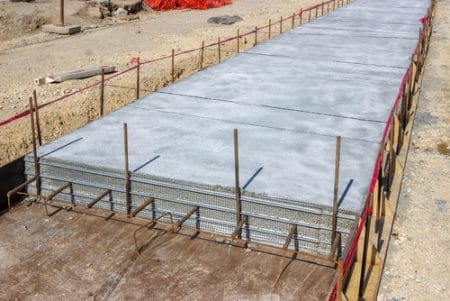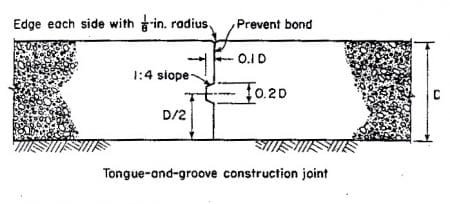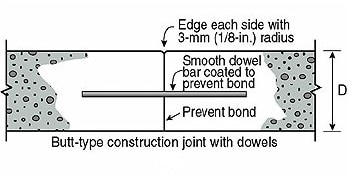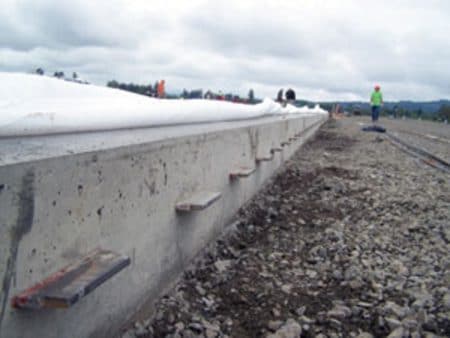Construction Joint in Concrete – Types, Location Selection and Advantages
Construction joint is placed when the mass concreting works are done and cannot be completed on a single stretch. The interface of the past day’s hard concrete and present days fresh concrete is to be properly done so as the bonding should be perfect for load transferring and avoiding water leakage. This interface joint is known as Construction Joint or Daywork Joint.

Fig 1: Tie bars used as dowel in construction joint.
In this article we study about the types of construction joints, locating of joints, quality and advantages of use of construction joints in concrete
Table of Contents
Types of Construction Joint
Construction joints are classified into 4 types depending upon the type of joint. They are as follows,
1. Butt Type Construction Joint
Butt-type construction joints are the simplest type of joints formed by a bulkhead and are satisfactory for thin floors that aren’t heavily loaded.

Fig 2 : Butt type construction joint
2. Tongue and Groove Construction Joint
Tongue and groove type of construction joint is usually given in slabs. The keyway may be formed by fastening metal, wood, or pre-molded key material to a wood bulkhead.
The second placing of concrete later enters the groove to form the tongue and thus allow for shear forces to be transmitted through the joint, In plain slabs on ground this ensures that future slabs will remain level with previously cast concrete.

Fig 3: Tongue and Groove Construction Joint
3. Butt Type Construction Joint with Dowel
This type of joint is done by just adding a metal or steel dowel in between the conventional butt joint. Dowels are provide to transfer load in floors carrying heavier loads.

Fig 4: Butt Type Construction Joint with Dowel
4. Butt Type Construction Joint with Tie bar
This is same as that of butt type construction joint with dowel, but the dowel used here is a tie bar. The tie bar is a deformed steel rod, which increases the surface area, which in turn increases the friction between the 2 concrete parts.

Fig 5: Butt Type Construction Joint with Tie Bar
Location Selection of Construction Joint
The selection of location of a construction joints is important for the durability and effectiveness load transfer. The following are the points to be remembered while locating the joints,
- Construction joints parallel to the slab span can be placed anywhere, except those locations in T-beam construction that rely on a portion of the slab to act with the beam in resisting flexure.
- For slabs and beams it is, therefore, usual to have construction joints at mid span of the middle third of the span. (ACI 318-11, Section 6.4.4).
- Joints in girders shall be offset a minimum distance of two times the width of intersecting beams. (ACI 318-11, Section 6.4.5).
- Designing concrete members for lateral forces may require special design treatment of construction joints.
- In walls a horizontal length of placement in excess of 40 ft is not normally recommended.
- It is convenient to locate horizontal joints at the floor line or in line with window sills.
- In the design of hydraulic structures, construction joints usually are spaced at shorter intervals than in non hydraulic structures to reduce shrinkage and temperature stresses.
- If the placing of concrete is involuntarily stopped for a time longer than the initial setting time of the concrete, the old surface is to be considered as a construction joint, and treated as such before casting is resumed. However from the point of view of strength of the structure, it is desirable to position construction joints at points of minimum shear.
- Shear keys, diagonal dowels, or the shear transfer method (ACI Code 318-11, Section 11.7) may be used.
Quality of Construction Joint
Construction joint quality is significantly influenced by the precision in the concrete placement. Maximum bond strength and water tightness are achieved by using quality concrete that has a low slump.
The concrete should allow fair amount of placement and consolidation. Segregation and bleeding trends of concrete encourages weak surface of low bonding behavior. The concrete surface produced should be clean and structurally reliable.
Rough aggregate protruding portions and slight indentation are not useful or recommended. Surface retardants are frequently utilized to attain a suitable surface.

Fig 6: Plate Dowels used in Construction Joint
Advantages of Construction Joint
The advantages of placing construction joint in the concrete are,
- Free horizontal movement of the floor
- Limited vertical movement
- Optimal load transfer
- Edge protection
- Prevention of cracks formed due to thermal variations.
- Proper jointing between two concrete placements.
No comments:
Post a Comment